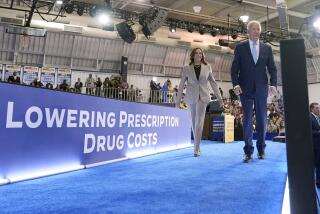Brand-Name Medicine Prices Outpace Inflation, Studies Say
WASHINGTON — Prices for brand-name prescription drugs rose by at least three times the rate of inflation last year, according to two new studies, and will leave seniors paying more for those drugs than they did a year or two ago even after Medicare discount cards take effect June 1.
The studies, released Tuesday by the liberal health advocacy group Families USA and the 35-million-member seniors group AARP, blame drug manufacturers for leaving seniors with increasingly unaffordable prices.
The groups said ever-larger price hikes over the last few years reflected the drug companies’ anticipation of increased sales to 41 million senior and disabled Medicare beneficiaries. Because the new Medicare law prohibits the government from negotiating with manufacturers for lower prices, consumers must pressure companies to control prices and on Congress and the Bush administration to legalize drug imports, the groups said.
“We had a golden opportunity to do something meaningful by letting Medicare bargain for drug prices, and the president and Congress failed to do that,” said Ron Pollack, executive director of Families USA. “The overwhelming majority of seniors will receive no help this or next year from skyrocketing drug prices.”
When Congress enacted the Medicare prescription drug benefit last year, the bill’s Republican supporters hoped to cash in with older voters in this year’s elections. But seniors have been critical of the new law, a reaction that the studies may amplify.
The Families USA study “confirms that the Medicare drug discount card is a fraud, and benefits the insurance and drug companies -- not the millions of seniors who need relief,” Sen. John F. Kerry of Massachusetts, the presumptive Democratic presidential nominee, said in a statement.
Bush administration and campaign officials strongly criticized the studies.
“For the first time, seniors do have someone negotiating prices on their behalf,” said Bill Pierce, spokesman for the Health and Human Services Department. “The private sector is negotiating on behalf of seniors. The card sponsors are negotiating directly with drug manufacturers, with wholesalers, with retailers, to provide discounts. This bill made that possible.”
Speaking at a healthcare event Tuesday in Youngstown, Ohio, Bush praised the discount cards, saying they would give most seniors “15 [%] to 25% off of brand-name medicines” and offer a $600 annual subsidy to low-income seniors -- individuals earning less than $12,569 and couples earning below $16,862.
The administration’s latest estimates peg the expected discounts at 10% to 17%.
AARP, whose support for the Medicare law was instrumental in its passage, has since focused on pressing the drug industry to limit price increases to the rate of inflation.
Its study of drug manufacturers’ prices for almost 200 brand-name drugs found increases averaging 27.6% from 2000 through 2003.
AARP officials highlighted another of the study’s findings: the rate of manufacturers’ price increases accelerated each year, from 4.1% in 2000 to 6.9% in 2003.
The AARP study found that drug prices increased last year at three times the rate of general inflation, which the group said was 2.2%.
“Only the manufacturers can really explain their behavior,” said John Rother, AARP’s director of policy and strategy. “But what seems to be driving [the accelerating price increases] is politics . . . their anticipation of a Medicare benefit.”
The pharmaceutical industry did not respond directly to that charge, instead arguing that the studies were flawed because they did not include generic drugs, which account for 52% of prescription drug sales, and compared drug price increases with the overall inflation rate, which was lower than the inflation rate for all medical services.
“The data clearly demonstrate that increases in drug prices are in line with medical inflation,” said Jeff Trewhitt, spokesman for the Pharmaceutical Research and Manufacturers of America.
Asked why drug prices were going up, Trewhitt pointed to the industry’s increased spending on research and development -- from $26 billion in 2000 to $33.2 billion last year. But the proportion of industry sales revenue devoted to research has “basically been steady” at about 18% over the last few years, he said.
Trewhitt sought to dispel one popular conception about drug prices -- that increases were driven in part by spending on advertising. “That number came down by $100 million,” from $2.7 billion in 2002 to $2.6 billion last year, he said.
The Families USA study, which looked at average wholesale prices for the 30 brand-name drugs most commonly used by seniors, found that prices increased last year by 6.5%, or 4.3 times the consumer price index for all items besides energy, which was 1.5%.
Prices for the five top-selling drugs for seniors increased even more: Lipitor, which lowers cholesterol, 8.3%; Plavix, which prevents blood clots, 7.9%; Fosamax, which treats osteoporosis, 6.9%; Norvasc, which lowers blood pressure, 9.9%; and Celebrex, which relieves arthritis and other pain, 8.1%.
*
(BEGIN TEXT OF INFOBOX)
Drug prices rise
Prices for the 30 top brand-name drugs used by the elderly increased an average of 6.5% between 2003 and 2004.
Five drugs that increased the most in price:
Drug/dose % change treatment in price
Combivent/1 mg Emphysema 19.8
Alphagan P/10 mg Glaucoma 15.5
Evista/60 mg 15.4 Osteoporosis
Diovan/80 mg 12.9 Hypertension
Detrol LA/4 mg 12.8 Overactive bladder
Source: Families USA
More to Read
Inside the business of entertainment
The Wide Shot brings you news, analysis and insights on everything from streaming wars to production — and what it all means for the future.
You may occasionally receive promotional content from the Los Angeles Times.










